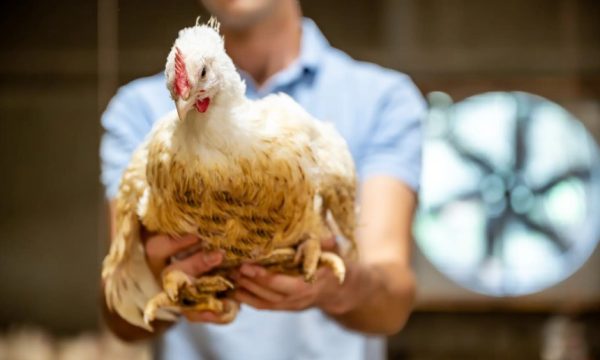Press release Broilers that grow just as well but emit less nitrogen

The best nitrogen-reducing measure is source-oriented. That was the basic premise of the doctoral study performed by Madri Brink (ILVO-UGent- Proefbedrijf Pluimveehouderij). Her trials with broiler chickens showed that fewer emissions occur when they are served feed with a slightly less protein. Additional beneficial effects can be achieved with age-appropriate feed and careful litter selection and management.
Broilers receive several feeds in their lifetime: a starter for the chicks, a grower as they mature and a finisher in the last weeks before slaughter. At the time of the comparison experiment, a classic feed consisted of 21.5%, 20.5% and 19.5% protein, respectively. Madri Brink: "When I reduced the protein fraction of the last two feeds by 1.75% and 1.5%, respectively (and compensated that with a small dose of synthetic amino acids that do not give nitrogen loss), I counted only half as much nitrogen emission by the end of production, compared to the classic feed. A remarkable difference! "
The classical and the experimental feed had exactly the same calorie content. The emissions were determined with a measurement just above the litter layer, because from that layer the ammonia particles volatilize and become nitrogen emissions in the atmosphere. The broiler chickens grew equally well with both feeds and their animal welfare remained the same. The air in the barn contained less ammonia with the experimental feed, which is more pleasant for the animals and for the poultry farmer.
A side note is that the final emissions coming out of a chicken house are strongly related to the condition of the litter layer: If it is drier (more granular), more nitrogen emissions result, but it is better for the chicken itself. If the litter with the droppings becomes a sticky flat moist crust, there are less emissions, but an increased risk of foot pad injuries. So ventilation (keeping the floor dry) is definitely also a factor in the nitrogen story.
Evelyne Delezie, ILVO poultry researcher and Brink's promoter: "More precise feeding, with a composition that exactly matches the age and approaches the minimum protein limit, is the lesson from this doctoral study. Indeed, since these experiments, I already see the feeds at field farms moving towards slightly lower protein contents.
These research results, if applied and guaranteed, can culminate in an officially recognized nitrogen-lowering measure.


